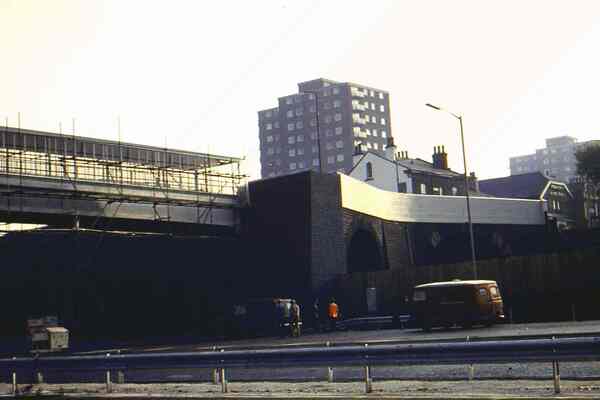
Dangerous crumbling concrete which the government says could require immediate building closures has been confirmed in Greater Manchester schools.
More than a hundred schools across England have been told by the government that they need to shut facilities or put urgent safety measures in place because of the presence of reinforced autoclaved aerated concrete (RAAC).
It comes just days before pupils are due to return for the start of the autumn term, and the announcement has led to widespread uncertainty for families.
The government says this specific type of concrete has now been classed as an immediate safety risk as it has the potential to suddenly collapse, and schools have been instructed they must take instant action if it is identified.
This could mean closing off buildings while mitigation measures are put in place, moving students to different sites, or potentially a temporary return to remote learning.
The LDRS understands that RAAC has been confirmed as being present in two academy-run schools in Trafford.
And a primary school in Manchester run by an academy trust has also identified the concrete in a communal area of its buildings, but it is not believed it will lead to closures of classrooms.
A spokesperson for Trafford council said:
Quote“We can confirm that two schools in the borough, Sale Grammar and Altrincham College, have been impacted by the government guidance on reinforced autoclaved aerated concrete (RAAC).
“We would like to reassure parents, carers, pupils and school staff that both schools will open as usual next week. Mitigating measures are in place and the schools are safe.
“The safety of pupils and staff remain the priority of the schools and the council.”
The Diocese of Salford, which runs more than 200 schools including primary, secondary and sixth form colleges across Greater Manchester, parts of Lancashire, and Calderdale in West Yorkshire, 21 of which are in Salford, has also confirmed that some of its buildings have been confirmed as containing RAAC, although it is unclear as to if any of those affected are located within Salford.
A Diocese spokesperson said:
Quote“We can confirm a small number of our schools have been identified but our priority is to work with the schools to inform and advise parents in the first instance.”
Bolton council said it had previously found one school in the borough containing RAAC, and safety work had been carried out.
Now the authority has confirmed it is investigating a further four schools to see if any contain the potentially dangerous construction material.
A spokesperson for Bolton council said:
Quote
“Following Department for Education (DfE) guidance a number of years ago, we surveyed all the community and voluntary controlled school buildings of the relevant age which the council has responsibility for.
“This process identified just one school containing RAAC, and the relevant safety work has already been completed.
“Following updated DfE guidance on age ranges, we will be assessing a further four schools over the next few days. In the unlikely event that RAAC is found, we will follow DfE guidance to ensure buildings are safe for pupils and staff.
“A small number of academy and diocese buildings in the borough may also be impacted by today’s announcement and we expect to be updated on the status of these schools shortly.”
A total of 156 schools in England have been confirmed to contain RAAC, the Department of Education has said. Of these, 52 have already put mitigations in place.
Now 104 schools have been instructed to immediately restrict access to spaces where RAAC has been confirmed.
However the list of affected schools – including state, religious and academy trust-run facilities – has yet to be confirmed by the government, and local leaders in Greater Manchester are also unable to provide full details.
The government said a list would be published once parents and carers have been informed via schools.
But the numbers of schools impacted could increase as more survey works across the country are undertaken.
However the LDRS can reveal that a special education college in Stockport has already been forced to close and relocate pupils earlier this year after RAAC was found in its roof in a ‘number of areas’.
The Seashell Trust had applied for planning permission for a new college, administration, sports and training building at its Cheadle Hulme based site – phase ‘C’ of a wider masterplan.
It came after RAAC was identified in the current college building during a building survey in April, which led to the Trust having to take ‘urgent and unprecedented action’ and immediately ‘permanently’ close the facility.
The DfE and an independent firm carried out surveys in the college building that had advised a number of rooms be taken out of immediate use in line with the government regulations.
Its college students and staff were relocated to other parts of the campus on a temporary basis but the Trust says this has ‘resulted in significant operational challenges’.
The planning documents add:
Quote“This immediate forced closure resulted in a 24-hour turnaround and has caused major disruption for the Trust, college staff and students,”
Eight of the Greater Manchester councils – Bury, Manchester, Oldham, Rochdale, Salford, Stockport, Tameside and Wigan – have confirmed that RAAC has not been found in any of their local authority schools.
The advice over how to deal with the presence of the concrete in school settings was changed after an RAAC beam collapsed during the summer, Schools Minister Nick Gibb has said.
The official advice states that in spaces where RAAC is present, ‘those spaces should remain out of use until appropriate mitigations are in place, even where they would have been deemed ‘non-critical’ previously’.
The building material was widely used between the 1950s up to the mid-1990s, and has a lifespan of around 30 years.
Education Secretary Gillian Keegan said: “Nothing is more important than making sure children and staff are safe in schools and colleges, which is why we are acting on new evidence about RAAC now, ahead of the start of term.
“We must take a cautious approach because that is the right thing to do for both pupils and staff.
“The plan we have set out will minimise the impact on pupil learning and provide schools with the right funding and support they need to put mitigations in place to deal with RAAC”.






Recommended Comments
There are no comments to display.
Create an account or sign in to comment
You need to be a member in order to leave a comment
Create an account
Sign up for a new account in our community. It's easy!
Register a new accountSign in
Already have an account? Sign in here.
Sign In Now